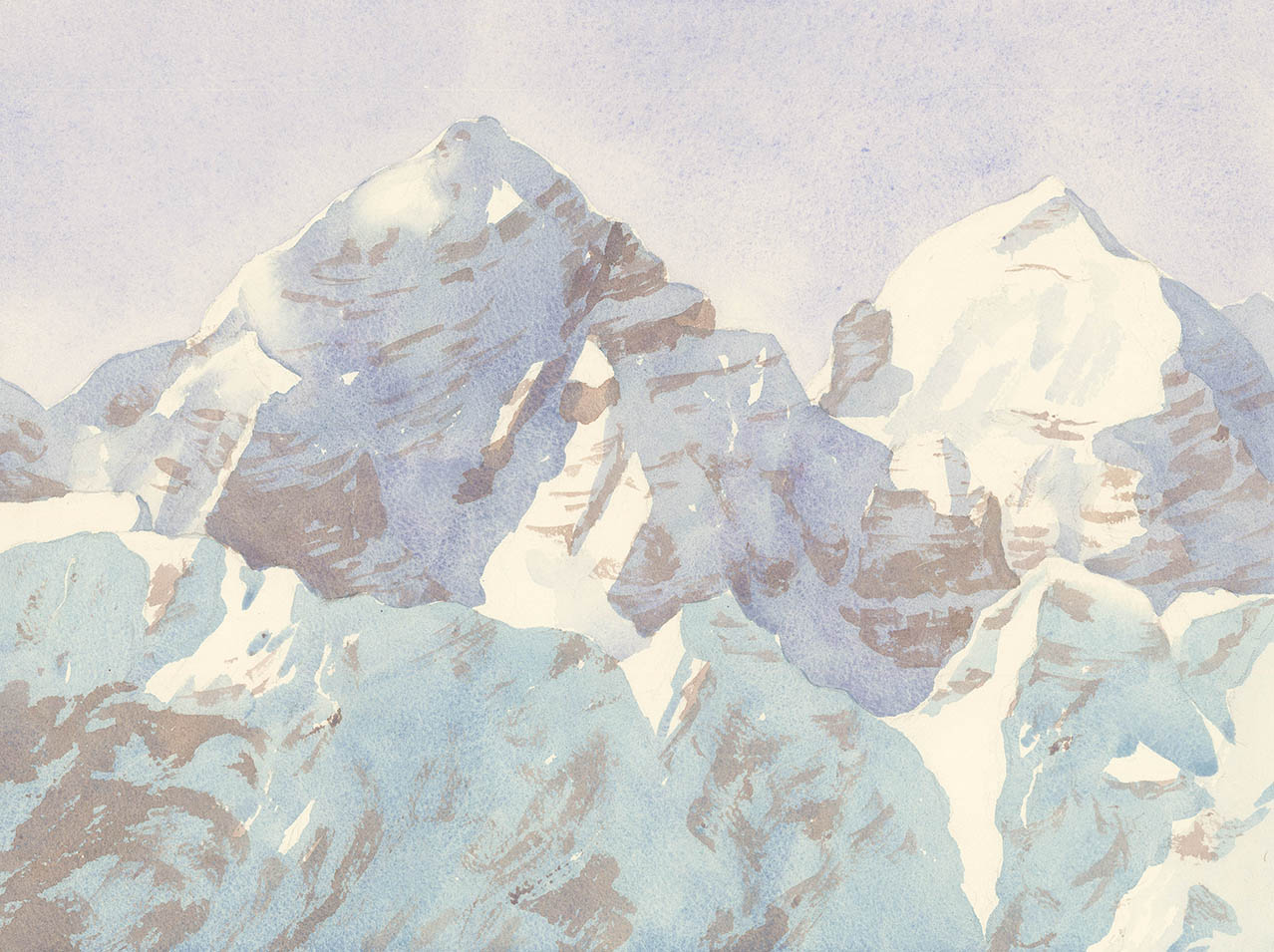
Tofane, Watercolor on paper, 2014, 12" x 16"
When did you first become interested in art?
I grew up in northern Italy, in a city called Udine, about one and a half hour north of Venice. No one in my family had any interest in art, but for some reason I always did. As a teenager, every other year, a friend of mine and I took the train to the Venice Biennale. Back then, I did not have the intellectual tools to understand what I was looking at, but I was curious and interested. Some of the people from my small city would look at the art and say "my five your old son could do that". I kept looking, fighting these prejudices, trying to stay open-minded.
How did growing up in Italy form your artistic experience?
Growing up in Italy meant being exposed to a lot of art from the past. In every church, even the small ones, the out of the way ones, you can find masterpieces. The contemporary art, however, was totally missing from my experience.
Was there a specific masterpiece you saw growing up that touched you deeply?
Not that I can remember, I don't even have specific memories of my visit at the Venice Biennale, other than the surprise for what could be considered art.
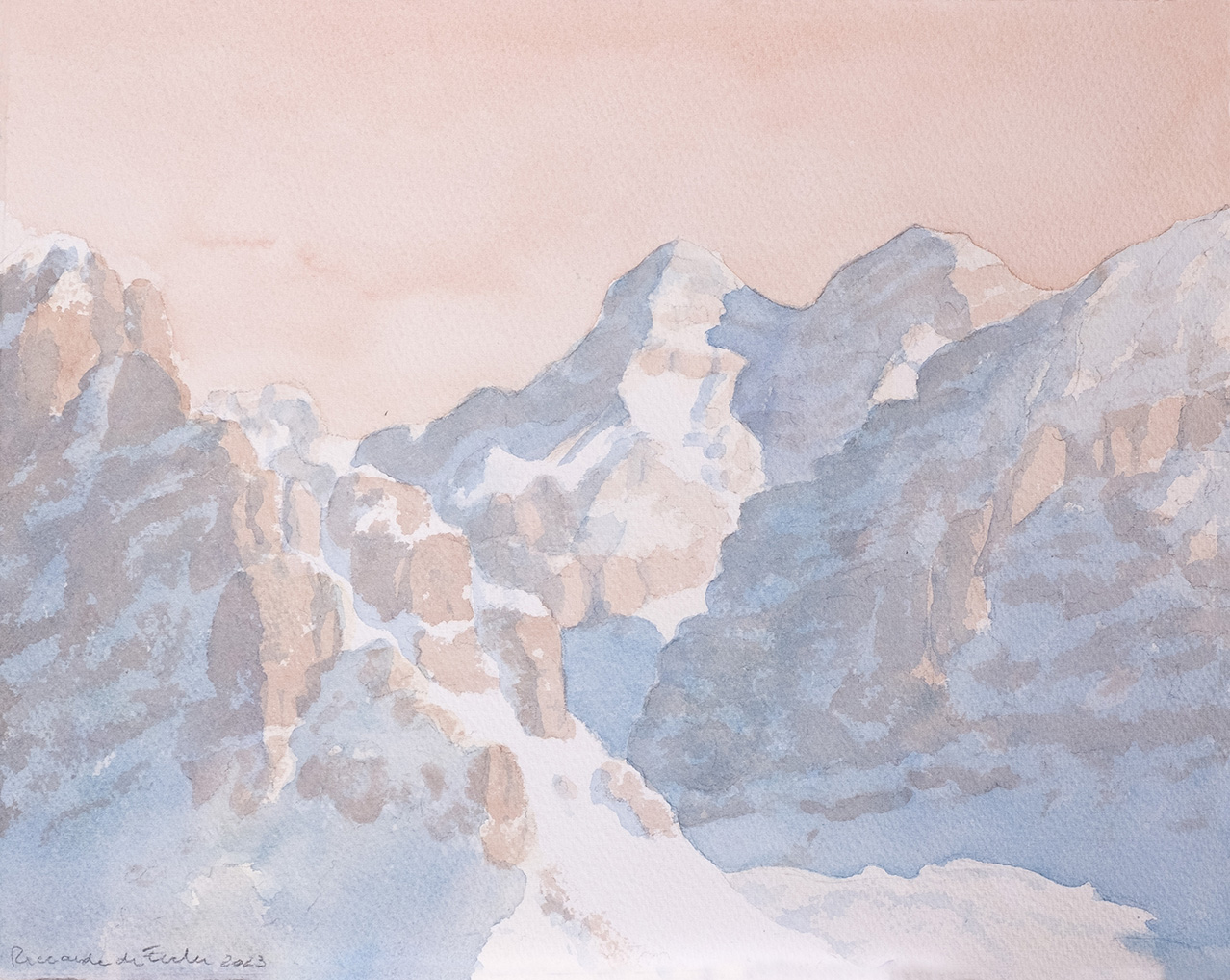
Tofane Rosa, Watercolor on paper, 2023, 11" x 14"
Who are a few of your favorite artists and what do you like about their work?
It's very hard for me to narrow down my favorites. I also came from a culture where such ideas do not exist. In the US every child is asked what their favorite color, favorite food, favorite everything is. From a young age, kids grow up having a personal leaderboard, as if it would define their identity, their uniqueness. This is not nearly as common in Italian culture.
It is not easy to put in words what could connect someone to a piece of art. Would you be able to say why you love Chopin or Bach? Nobody would ask that question about music, but for some reason it is normal to do it with art.
I love Giorgio Morandi. He spent his entire life in the studio in Bologna simply painting a bunch of bottles. Always the same ones. His work takes the attention away from what he paints to make you focus on the painting itself. He was able so simplify it over and over, staying connected to his subject. Someone said that his paintings are full of silence, I agree with that. Morandi paintings are full of silence and emotions. I also love his colors (that are not that different from the ones of the Dolomites, the mountains that I paint).
Among the more contemporary ones, the artist that inspires me the most is Jasper Johns. In his work I admire how he was able to create his own language and find a pace that led him from painting to painting. I do not want to call it “a method”, because that would seem too mechanical. Maybe it’s better described as an alphabet, built in a painterly language.
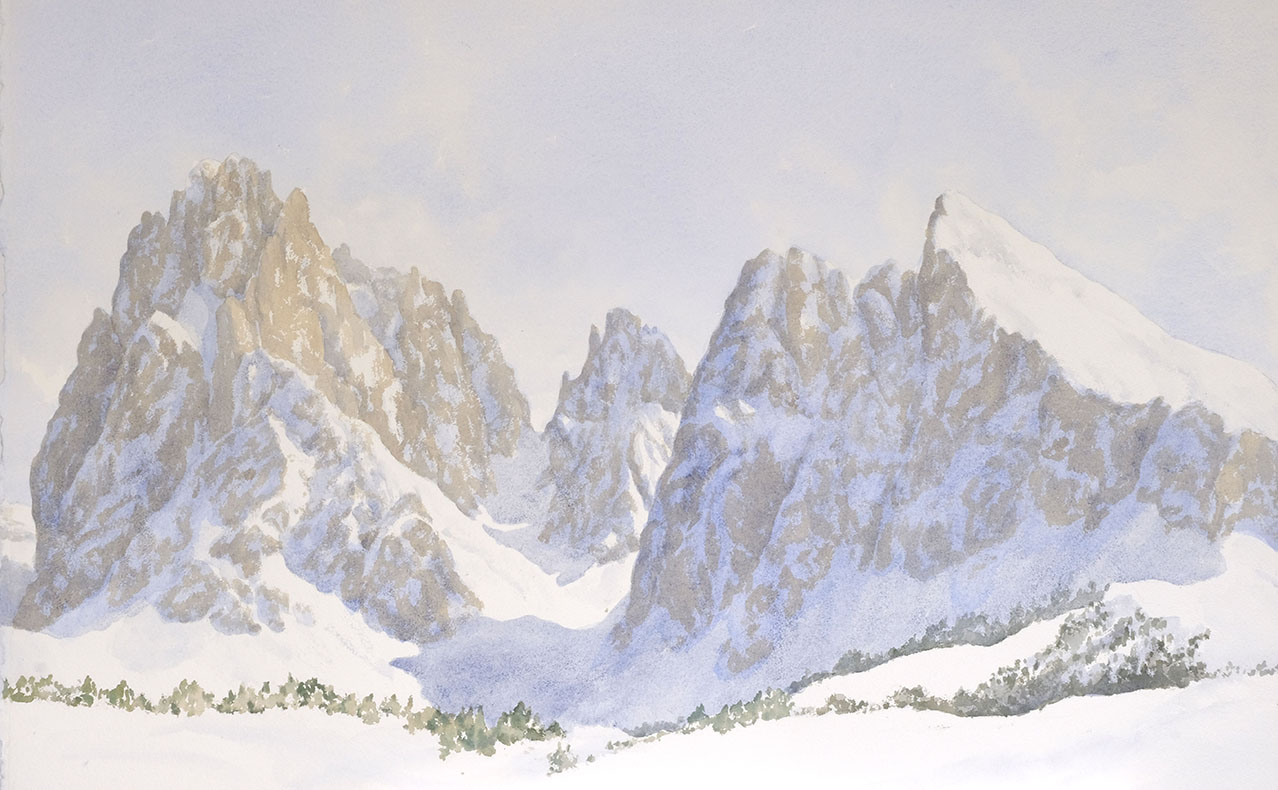
Sassolungo e Piatto, 2023, Watercolor on paper, 26" x 41"
How did you find your way to New York?
I was 21 years old and my very first trip was to the United States.
A friend of mine and I took a "hippy like" trip. We flew to San Francisco (we called it Frisco then. It was 1976) and then arrived in New York two months later, by Greyhound bus. I always had a love-hate relationship with the US. On one side, I have always been attracted to how it is capable of regenerating itself and welcoming new information. The contribution of black feminism, and the world changing revolution that originated in Berkley, California, are just a couple examples. I also have a lot of criticism for the American economic system, and the effects that it has on more marginalizes layers of the population.
I sure didn't anticipate that nine years after my first trip, I would meet an American man who would become my lovely husband.
What was your first introduction to the New York art world?
In my imagination, the United States was all about nature, mountains, big spaces, music, and the Beat Generation. New York City did not match any of these categories. The charter flight requested that I be in NYC a week before departing so we went there just to catch a flight back to Europe. I fell in love with New York in about five minutes. I had a week to visit the Museums and I even went to a John Baez concert at Madison Square Garden. It was memorable. In the Guggenheim Museum, looking at a non-representational painting, I remember the exact moment when this magical thing happened. Standing in front of a small Kandinsky sand painting, all of a sudden, I felt emotionally connected to that image.
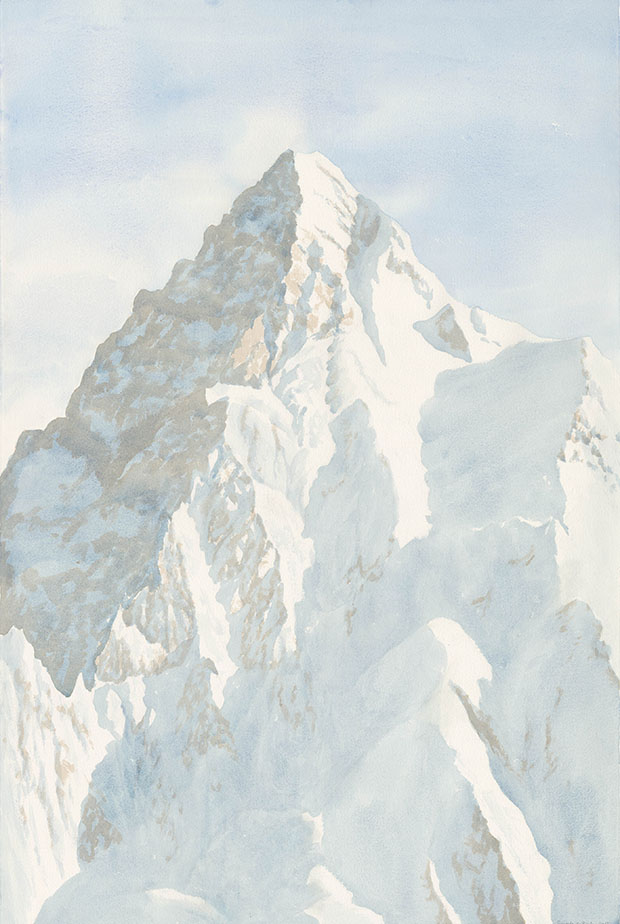
K2, 2022, Watercolor on paper, 60" x 40"
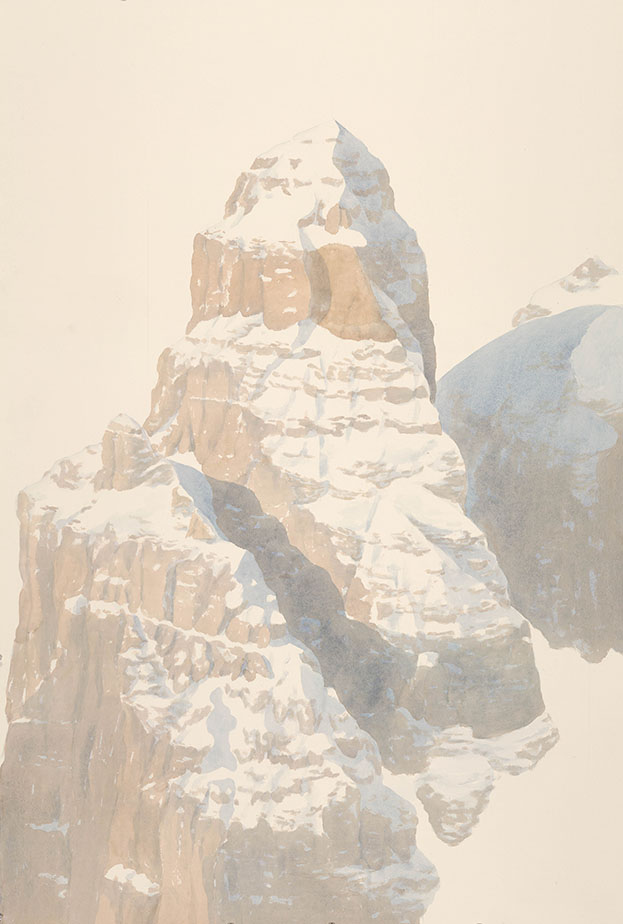
Torre Fanis, 2017, Watercolor on paper, 60" x 40"
I know you are an avid hiker. What are a few of your favorite mountains you have climbed?
Mountains have always been central to my life. Even if I think about it quite a bit, I can't find a good reason why I love them so much. I was never able to find a logical explanation.
My approach to the mountains changed through different phases of my life. As a child my parents occasionally went hiking, but they brought along only my older brother, because he was a boy in a heavily patriarchal family. I had a sense of longing that nourished my desire for the mountains by its own absence. My family moved from a mountainous area, near Bolzano, to Udine, at the footstep of the Carniche Alps. I was 11 then. The mountains were further away, and I could only see them on certain clear winter days. I had no way to go near them. My family had a second house in the countryside, even further away from the alps. When I was a teenager, my father went hunting in the mountains. I remember him telling stories about hiking in the snow with his rifle. I tried to ignore the parts about killed animals, but the description of his walking in the snow with snowshoes, the silence and the atmosphere up in the mountains, stayed with me. Hunting was not an activity for girls, and once again, I was left out. Then when I was eighteen years old, I met a guy in school that was a rock climbing instructor. I saw in him the possibility to find my way to the mountains. And that I did. The climbing years were magical. I did quite a bit of climbing, also on what was then considered difficult. I opened new routes and was lucky enough to participate in the first two Italian Himalayas expeditions that included women. On the first expedition, in 1977, we climbed Annapurna III, and in 1980 Mount Everest. Due to a variety of factors, we did not reach the top on either one but the experience was fantastic.
You asked me if I have favorite mountains, and in my answer I detoured a little bit. I guess that if I had to pick, the Dolomites are on the top of my charts.
Do you have a mountain you go back to over and over again?
I do have places that are particularly dear to my heart. Places that I go back to over and over. Especially in moments when my life changes, it bewilders me that the mountains are always there, still and steady to witness and remind me who I was and who I became. Mount Pelmo, is one of them. In fact a friend of mine, to make fun of me, said that I am affected by "Pelmites", a disease he made up combining "Pelmo" and "Dolomites".
How does hiking inspire your work?
I think that the emotional connection that I have with the mountains is fundamental to my practice. For me, it is the proximity to the mountains that connects me to my deepest self and enhances a sense of gratitude and love. I would have the same feeling for abstract or non-representational paintings.
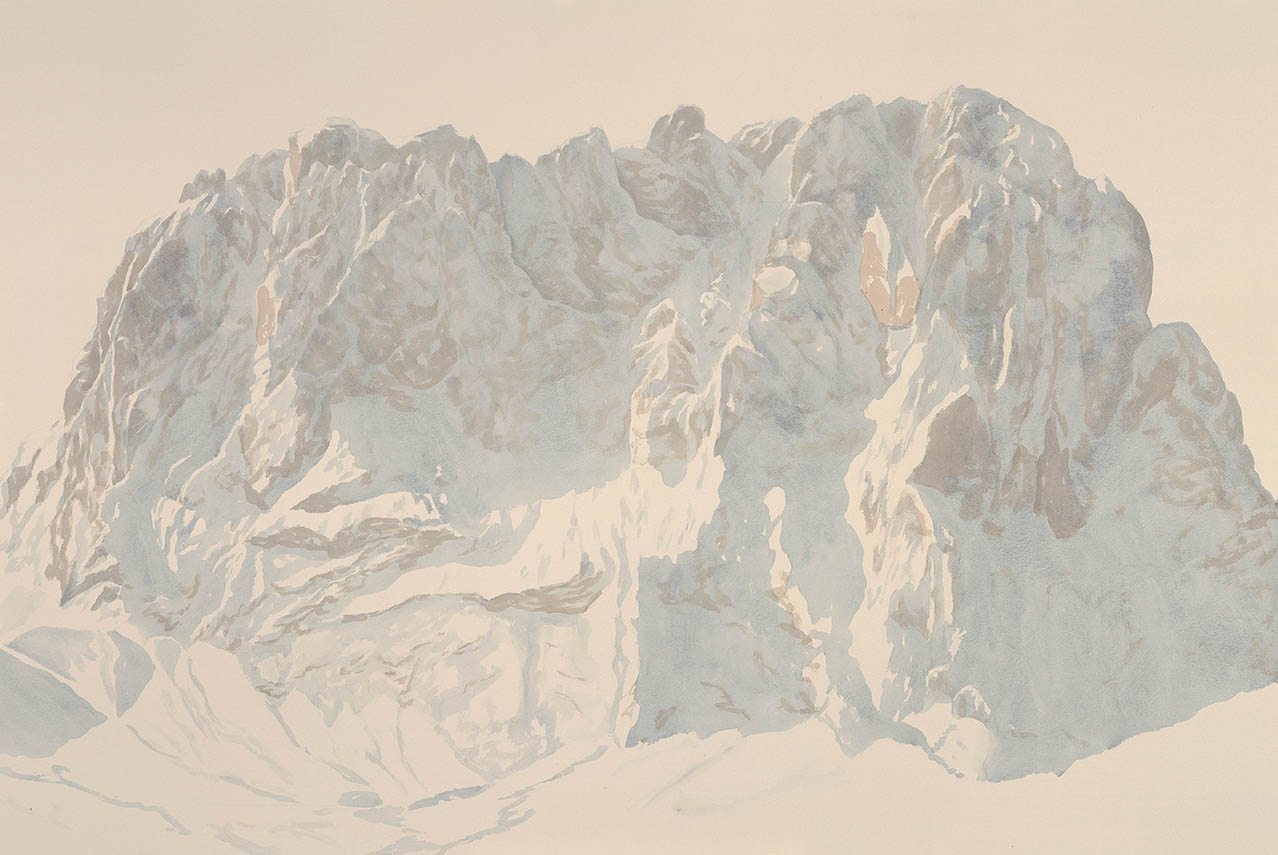
Sassolungo, 2017, Watercolor on paper, 40" x 60"
When did you decide to focus on watercolor as your medium of choice?
I could not call it a choice. I started to paint using watercolors, for the simple reason that it was easy to pack in my backpack and bring it with me while hiking. I fell in love with it. The transparency of the pigments lets the luminosity of the paper show through, and that suits my subject. Maybe the challenge of how difficult watercolor is, also played some part in my decision.
What is your creative process when developing a new body of work?
My life as an artist is relatively young (even if I am not a young person myself). I do not see my work as having these broad cycles, or a body of work, as you called it. I put one foot in front of the other and I keep working. Same as you do when you climb up a mountain.
I know you are a big supporter of female artists and feminist ideas. What kind of projects are you involved in?
In recent years, I worked on bringing attention to the intersection of mountains and feminism. Mountaineers are, far too often, a macho-oriented crowd. Together with a friend of mine, I organized an event at Trento Film Festival (the oldest Mountain Film Festival in the world). We explored the relationship between motherhood, and the inherent risks female mountain climbers face. In our community, when faced with death, people rarely consider if the climber was or was not a father. Often however, if the climber is a mother, she is criticized for being irresponsible, as if parenting is only a women's problem.
How does location and environment affect what you are working on in the studio?
I have my best time when I paint on-site, and I am a different painter while I do. When you are up in the mountains with your easel you always have a time issue. The light changes fast, and so do the shadows that the mountains cast. It forces me to paint fast, to eliminate details and to annotate only what is most important. My paintings, onsite, look different. I live far away from my beloved Dolomites, and most of my work is done in studio, in Oyster Bay Long Island. I paint very large, which suites the majesty of the mountain. It would be simply impossible to work so large in watercolor, on site. This distance, however, is not necessarily negative. It filters what is important and what is not. Sometimes I see that my painting seem "dusty", like they would have a veil of nostalgia.
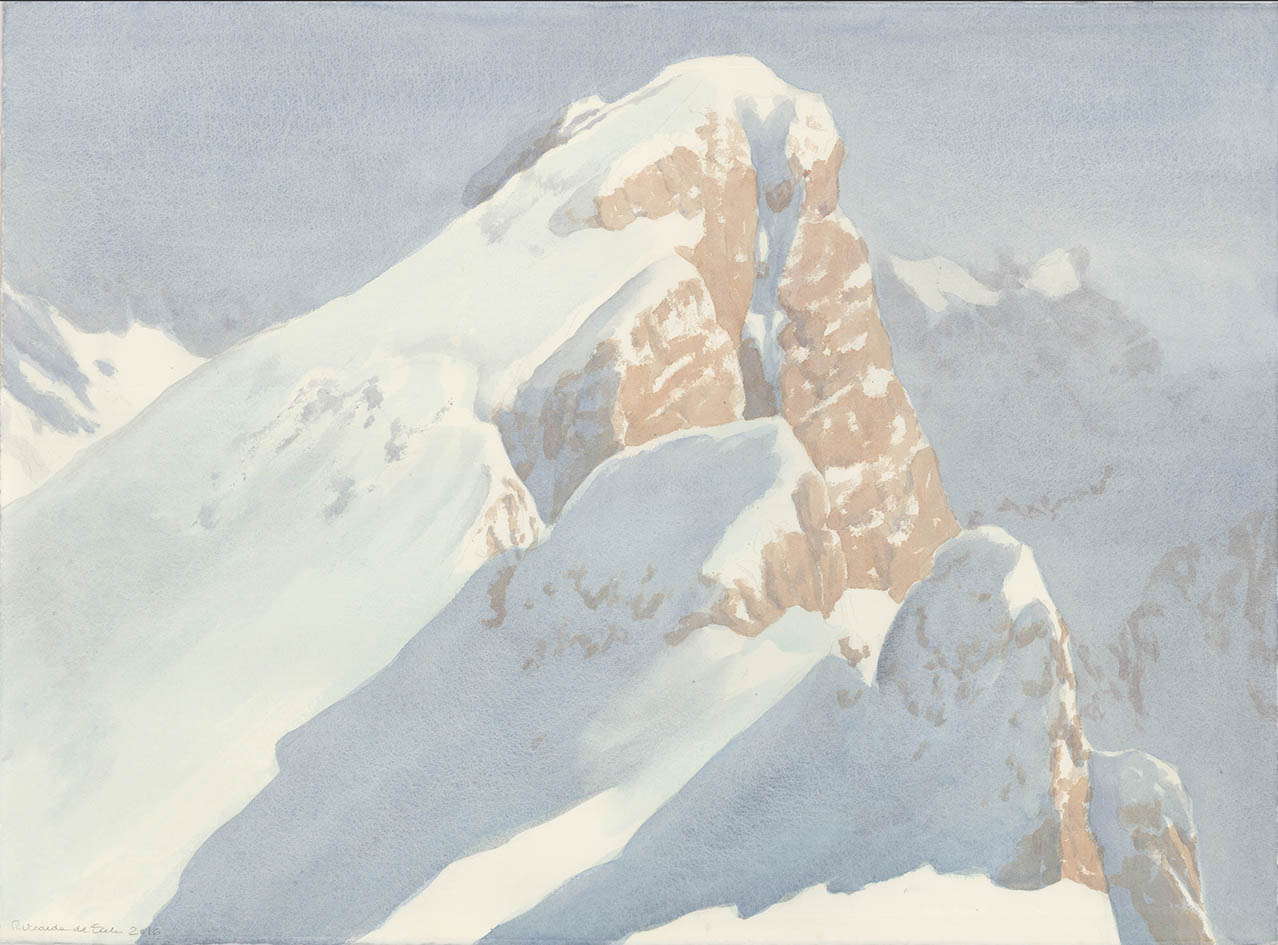
Gusela, 2016, Watercolor on paper, 22" x 30"
The last few years have been really challenging. What kinds of things have you experienced that have changed your studio practice?
When Covid started, my husband and I were in Italy and we stayed there for over a year and a half. I have a very beautiful studio, less than five minutes from our apartment. Even during periods of stricter lockdown, I continued to go to the studio. I had no distractions, and I could concentrate deeply on painting. It was a very painful time, but for me also a productive one.
What are you currently thinking about and working on?
I am very much reflecting on how climate change effects my beloved mountains, and how I can protect them directly through my work.
What are a few things that you have read or seen lately that have been inspirational?
I am now working on an article on Ferdinand Hodler, an artist I love. I believe that if Hodler would have been living in Paris, instead of Switzerland, we would all have heard more about him. As a young man he copied late romantic paintings to be sold as souvenirs, and then after developing his own language, took off as an artist. Looking at his work, I see exactly what he saw in the Swiss mountains, and how he decided to translate it in his brushstrokes.
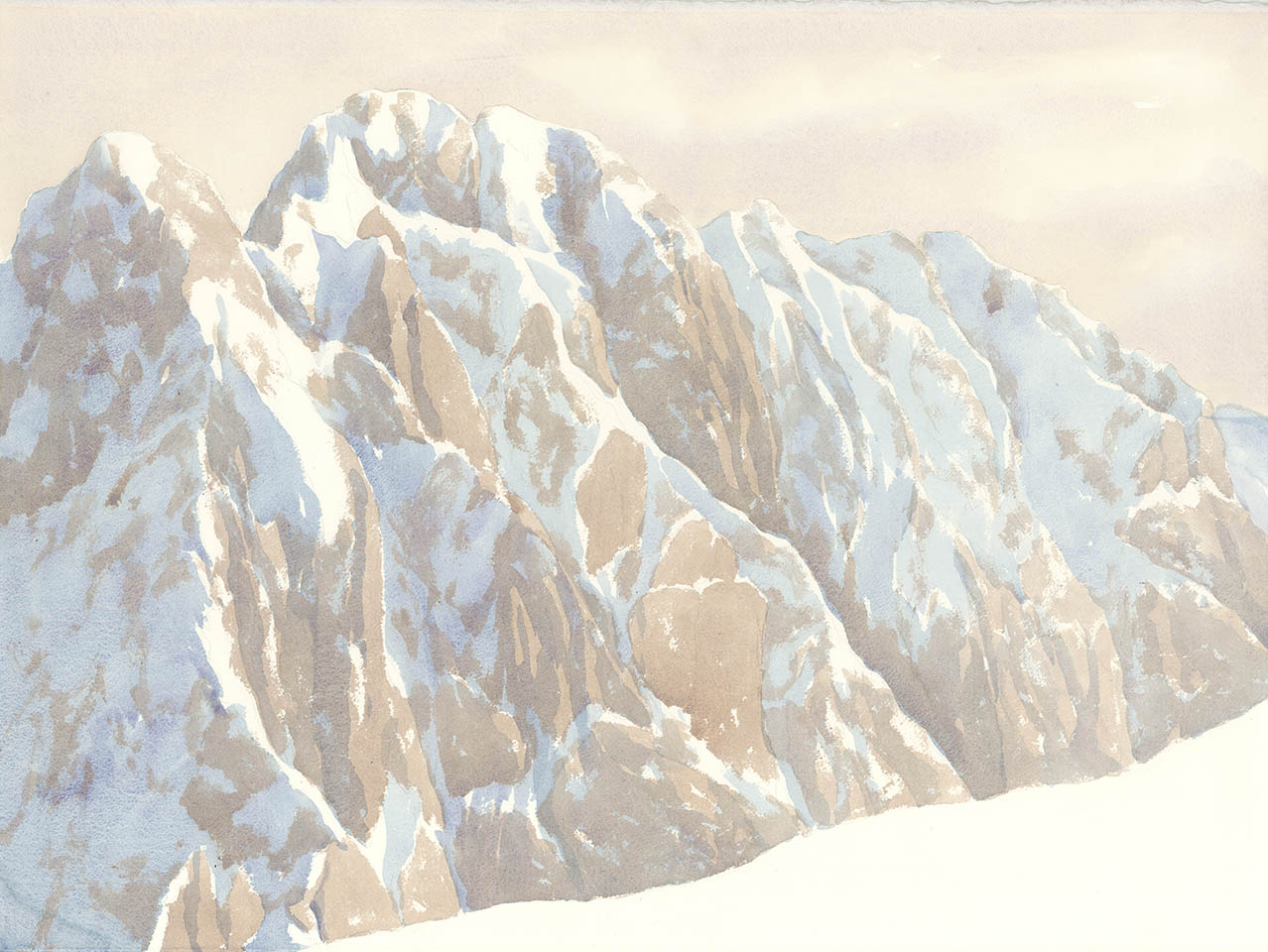
Creta delle Chianevate, 2015, Watercolor on paper, 22" x 30"
Tell me about a really memorable moment or moments you have experienced as an artist?
The image that I decide to paint has to be translated into a pictorial language, made by lines, colors, temperatures, angles, etc. In watercolor, you must have a clear plan from the very beginning. The color white does not exist in your pallet. The color of the paper is your white and it needs to be saved. You build the image from light to dark. The possibilities of correcting a mistake are very limited. The painting should also feel fresh, like it painted itself. Every time I finish a painting and I look at it as a finished work, I am surprised by how the sum of what I see and what I know comes together to create an image that looks three dimensional and alive. I remember flipping the sheet of paper over and reflecting on the fact that on one side there was a white piece of paper, and on the other, I had created a whole world.
Besides hiking, what do you do to just relax and get away?
I enjoy being in nature in every kind of environment. Mountains are my favorite, but I love every form of outdoor life. I am an avid reader, the older I get the more curious I become, and I love reading about very different things. I also like to knit and to sew my own clothing.
If you could give advice to your younger self - what would it be?
Have more faith in yourself.
